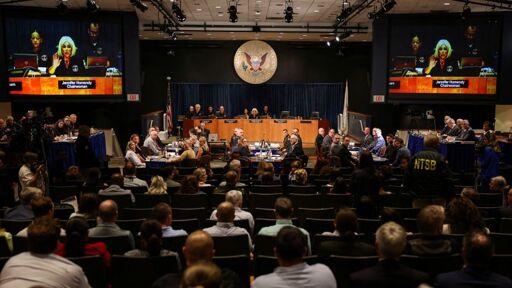Kudos to the journalists who authored this article. It’s about as close as you can get to excoriation while remaining objective.
The helicopter route at the time of the collision allowed the Black Hawk to fly as close as 75 feet below planes descending to land on runway 33 at Reagan National Airport, according to the NTSB. With allowable errors in the helicopter’s altimeters and other equipment as well as Army rules expecting aviators to hold their altitude within 100 feet, it could end up being much closer.
“How much tolerance should we have for aviation safety whenever civilian lives are at risk?” asked Todd Inman, NTSB board member. “How much is that tolerance,” he continued. “I think it should be zero.”
Sounds like the tolerances weren’t big enough! Odd interaction putting those two paragraphs next to each other. NTSB demanding zero margin for safety…
NTSB demanding zero margin for safety…
Not zero margin, zero tolerance in the margin. Very different things. If you have a margin of error of 200, and each side has a tolerance of 100, both can be technically in tolerance but still collide. You want that margin to be larger than the tolerances combined, plus additional margin for human error and real world conditions. And then, if possible, double or triple that.
The altitude systems being able to be 100 feet off while at low altitude and a separation of 75 feet is absolutely insane.
Right. I know my friend in civil engineering plans bridges as if they have 18 wheelers stacked end to end, fully loaded across the bridge, and then doubles that number. I think he’s mentioned other types of projects use safety margins of three or five multiples.
“They didn’t ask for it,” said Katie Murphy, safety culture program manager at the FAA. “They asked for ‘hotspots.’”
Frustrated, Homendy read a detailed report from a working group identifying the problems around Reagan National Airport and asking for action, while apparently using the wrong terms.
“Are we really going to say, ‘Whelp, they didn’t do enough?’” Homendy asked. “I don’t get it. Every sign was there that there was a safety risk and the tower was telling you that… but you guys are pointing out, ‘Well, our bureaucratic process, somebody should have brought it up at some other symposium.’ Are you kidding me? Sixty-seven people are dead.”
Yep, this sounds like the main issue.
The helicopter route has since been closed, but NTSB Chair Jennifer Homendy said she doesn’t believe “anyone did the math until the NTSB did the math” to determine how close planes and helicopters were getting until after the crash.
There are technical aspects, like how the Black Hawks report incorrect altitudes while flying fast over the river, but this strikes me as the largest cause: nobody valued the controllers pleas sufficiently to do proper management of heli routes around the airspace.
And by nobody, that’s probably the FAA who had the responsibility of doing it.
What could possibly go wrong, after all? They surely were making a big todo over nothing.
To me it sounds like multiple relatively minor errors coalesced around tragedy. There is lots of data to inform changes to fine-tune a congested airspace. It also looks like the military’s culture of safety has slipped and they’ve forgotten how intricately of an operation this all is when their operations are do closely intertwined with a commercial operation. That could potentially indicate the need for large systemic change pending further investigation.
What I don’t see is an obvious call for outrage; for heads to roll; to tear down the system to start over. Idk if there’s footage but the article writing makes it sound like Homenday is playing up the drama, but she could also just be passionate in what she’s saying.
I’m seeking comfort in the belief that one of our damn systems in this country still functions. Sometimes we just need to read the post-mortem, make the changes, and let insurance pay the grieving families.
Unfortunately air traffic control has been underfunded and understaffed for multiple decades at this point… It’s no surprise that our aircraft are falling out of the sky now that Trump gutted the FAA, even if this particular tragedy was longer in the brewing.
You’re right that heads may not need to roll - but there needs to be a huge national push to train and hire new air traffic controllers, and to modernise all the ATC equipment at airports. We need to give the profession the support it’s been asking for.
I’ve been flying my whole life so I’m very comfortable with it, and even I’m unwilling to get on a plane if I don’t have to nowadays. I can only imagine the numbers of my company in that, but I doubt I’m alone, and if that attitude is spreading it’s bad news for airlines that are already struggling.
Oh, so it really is just oligarchy keeping us all imprisoned by the same fucking labor rights erosion and workplace pressure we’re getting in every industry. It just stands out to us because people died this time. I’m not sure that makes it stand out to them.





